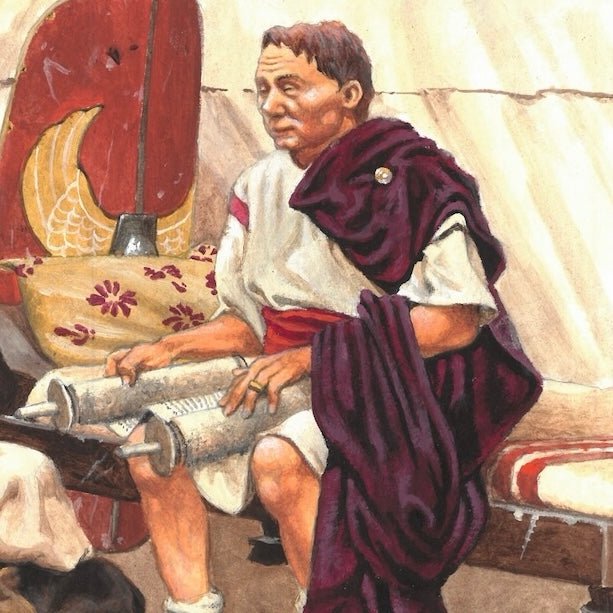Battles in the ancient world (part 6)
This is the sixth in a series of eight blog posts on different types of battles fought in the ancient world. In earlier posts, I discussed pitched battles or “set-piece” battles, meeting engagements,surprise attacks, ambushes, and skirmishes. In this post, I will focus on another particular type of battle: the raid.
The raid
A raid can be considered a particular type of skirmish, even though the aim of the raid is more important than the actual scale of the engagement. In a skirmish, the object is to defeat the opponent, either by annihilating the enemy troops or by forcing them to rout and abandon the field. In a raid, the aim is different, and the battle usually ends once the instigating party has reached its objective. The aim of a raid can be to assault the baggage train of an enemy army, to acquire supplies, or to assassinate an enemy leader. They typically rely on hit-and-run tactics: one attacks, tries to achieve the objective, and then flee the scene before the enemy is able to mobilize fully and counter-attack in force.
Raiders typically attacked their enemies by land or by sea. Famous seaborne raiders were the so-called Sea-Peoples that assaulted Egypt towards the end of the Bronze Age (see also Ancient Warfare IV.4). The Sea-Peoples were a group of raiders that may have come from disparate regions of the Mediterranean, including perhaps Sardinia and the Aegean. Many scholars believe they also invaded Cyprus, the Levant, and the kingdom of the Hittites, before settling in what is now Palestine.
Raids were a common feature of the Homeric world. The elderly Nestor tells a story of how the rival Epeans once stole a chariot that belonged to his father. In retaliation, Nestor led a party of young men on a raid against them and thus acquired a large amount of livestock and prisoners (Il. 11.669–704). In the same way, we hear of a story of how the people of Ithaca were once attacked by people from the mainland. Rather than attack them in turn, Laërtes sent his son Odysseus to demand compensation (Od. 21.15–21). Raids of this type are a common feature among less complex societies; we know that, for example, the ancient Celts and Germans also engaged in cattle-raiding between neighbouring communities. Herodotus even claims that the tit-for-tat stealing of women was at the core of the conflicts between Europe and Asia, dating back to when Zeus abducted the young girl Europa from Phoenicia.
Within the context of Homer’s epic world, a common question that someone might ask a visitor is whether or not they are on some kind of business or merely “roving like pirates do”. The differences between traders and pirates were usually slim, especially early on. Already in Homer, the Phoenicians appear as archetypical traders that could not be trusted, and would sell their passengers as slaves when given half the chance. Though generally speaking, those whose main aims were largely predatory typically sailed the sea aboard sleek warships, whereas genuine traders preferred merchantmen; the contrast is particularly clear on the so-called Aristonothos Krater, briefly discussed in Henchmen of Ares. The main scene on the vase features a round-bottomed merchantman about to be attacked by a sleek galley, as shown in the reconstruction that Angel García Pinto made for the book. (See also Arnold Blumberg’s online Ancient Warfare article on piracy in the Archaic and Classical Greek world.)
Greeks, especially those from Ionia, a region in western Asia Minor, acquired a reputation for piracy early on. We have Assyrian sources dated to the reigns of Tiglath-Pileser III (r. 725–727 BC) and Sargon II (r. 722–705 BC) that mention how the coasts were being harassed by “Ionians”, clearly pirates. The Assyrians apparently managed to catch some of these troublemakers, as we hear of Greek slaves kept at Nineveh. Herodotus also tells of Ionians and Carians that were blown off course and ended up in Egypt, where they started raiding the Delta. These “brazen men” were then hired by Psamtik I (r. 664–610 BC) to fight for him as mercenaries.
Piracy remained common throughout much of the ancient world. According to Plutarch, Julius Caesar was once taken captive by Cilician pirates when crossing the Aegean Sea. They wished to ransom him for twenty talents of silver, at which point Caesar burst out laughing, saying that they had no idea whom they had managed to capture and offered to pay them fifty talents instead. He also promised them that he would hunt them down once freed. The pirates did not take this threat seriously, but upon his release, this is exactly what Caesar did. He arranged a fleet at Miletus and immediately sailed back an island where the pirates had stopped. He managed to take them prisoner and, when the Roman governor of Asia in Pergamon proved unwilling to execute them, he had them crucified himself.
In order to acquire provisions and other supplies, large armies could also send out small detachments to raid the local countryside and small towns. Cavalry troops were particularly effective because of their speed, and could be used to assault enemy supply lines. Prior to the Battle of Plataea (479 BC), the Persian commander Mardonius frequently sent part of his cavalry to harass the Greeks, attacking their convoys and disrupting the supply lines between the nearby Greek camp and the rest of the country. Such raids were often instrumental in goading an enemy into battle or to force them to abandon an otherwise strategically advantageous location.




